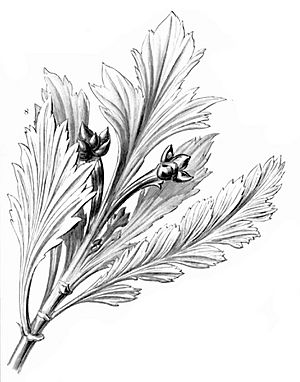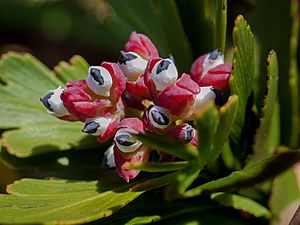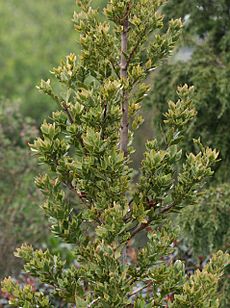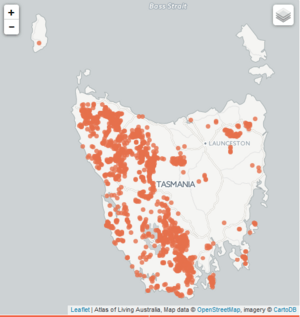Celerytop pine facts for kids
Quick facts for kids Celerytop pine |
|
|---|---|
 |
|
| Conservation status | |
| Scientific classification | |
| Genus: |
Phyllocladus
|
| Species: |
aspleniifolius
|
The Phyllocladus aspleniifolius, also known as the celerytop pine, is a special tree found only in Tasmania, Australia. It grows all over Tasmania, especially in the western highlands. Its unique 'leaves' look a lot like a celery plant, which is how it got its common name.
Contents
What Does It Look Like?
The celerytop pine is a large, cone-shaped tree. It belongs to a group of plants called conifers. Its trunk stands tall with branches that spread out sideways.
When the tree is very young, it has small, needle-like leaves. But as it grows older, its true leaves become tiny brown scales. The job of making food for the tree is taken over by special flattened stems called cladodes. These cladodes are green and shaped like diamonds. They are thick and flat, usually 3 to 8 centimeters long.
Cones and Seeds
Celerytop pines can have both male and female cones on the same tree, or on separate trees. They usually produce cones in the summer.
- Male cones are shaped like small cylinders. They are about 3 to 5 millimeters long. You can find them in groups of 2 or 3 at the ends of side branches.
- Female cones grow in small groups of 3 or 4. They are found on short stalks near the cladodes.
When the female cones are ready, they turn a bright pink or red color. Inside, a white, fleshy part called an aril holds a hard, black seed.
Where Does It Live?
The celerytop pine is found only in Tasmania. It is the most common conifer tree there. You can often find it in wet forests and rainforests. It grows from sea level up to 1200 meters high. It is most common in the west and southwest of Tasmania.
You might also see smaller groups of these trees in the north and east. In very high places, they can grow as short, bushy shrubs.
Forest Homes
Celerytop pines are a key part of the cool temperate rainforests in Tasmania. They often grow alongside other rainforest trees like Nothofagus cunninghamii (myrtle beech) and Atherosperma moschatum (blackheart sassafras).
These trees grow well on acidic soils. These soils often come from rocks like dolerite or granite. The soil needs to drain well and can be found on rocky slopes. Celerytop pines prefer areas with lots of rain and no long dry spells.
They need more sunlight than some other rainforest trees. They can grow well in forests that have had fires, as this helps new trees sprout. The biggest celerytop pines can live for up to 800 years!
How People Use It
The wood from the celerytop pine is very valuable. It is used by people who make fine furniture and wooden boats. The tree grows to a medium size in the forests.
The wood is straight-grained and strong. It has a golden-brown color and is very durable. This means it lasts a long time. It is also easy to work with and does not shrink much. People use this wood for:
- Railway sleepers (the wooden beams under train tracks)
- Flooring
- Ship masts
- Furniture
- Cabinets
Other Uses
The celerytop pine can also be grown in pots. However, it grows very slowly. It likes cool, moist, and acidic soil. This means it needs to be watered often when grown in a container. Because of this, it is not very common in home gardens. You might mostly see it in botanic gardens or special tree collections.
Scientists have also used this tree to study climate change. The way its tree rings grow can tell us about past weather conditions. This helps us understand how the climate has changed over time.
Protecting the Celerytop Pine
The biggest challenge for the celerytop pine is logging. Its valuable wood means it is often cut down. It grows in wet forests that are sometimes cleared for timber.
However, many celerytop pines are found in protected forests in Tasmania. Other areas where it is logged are managed carefully. This helps make sure that native trees can continue to grow there. Because of this, the species is listed as "Least Concern" by the IUCN Red List. This means it is still common and not currently at risk of disappearing.
Images for kids
See also
 In Spanish: Phyllocladus aspleniifolius para niños
In Spanish: Phyllocladus aspleniifolius para niños







